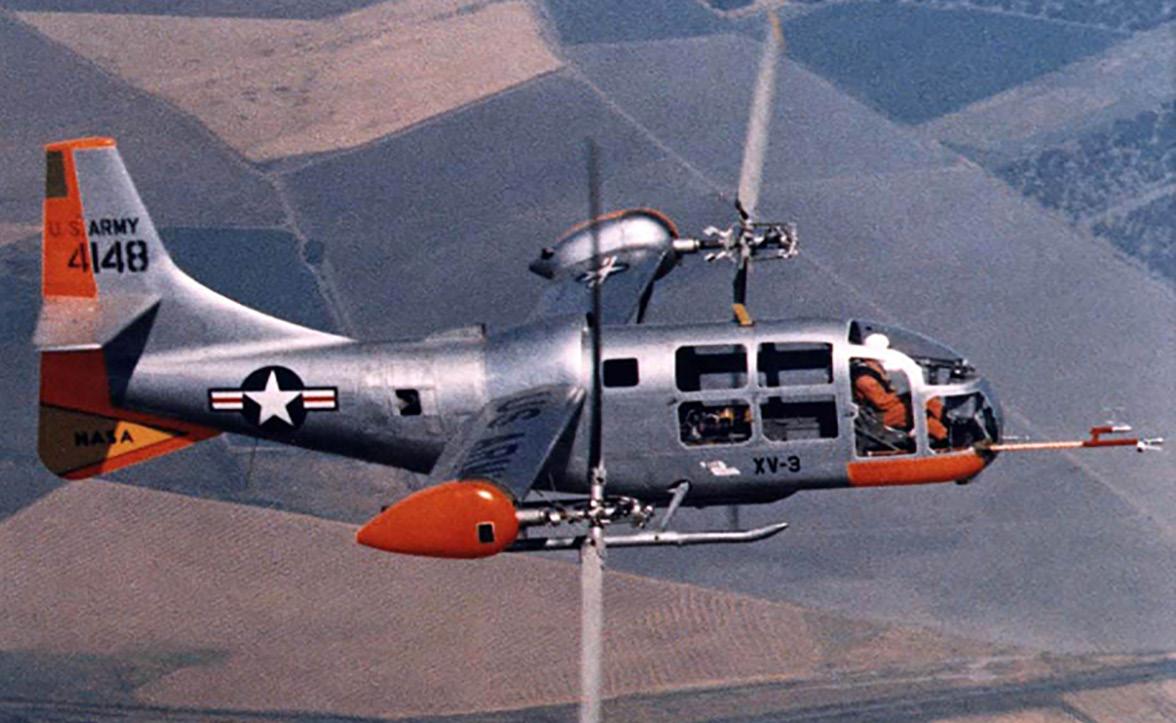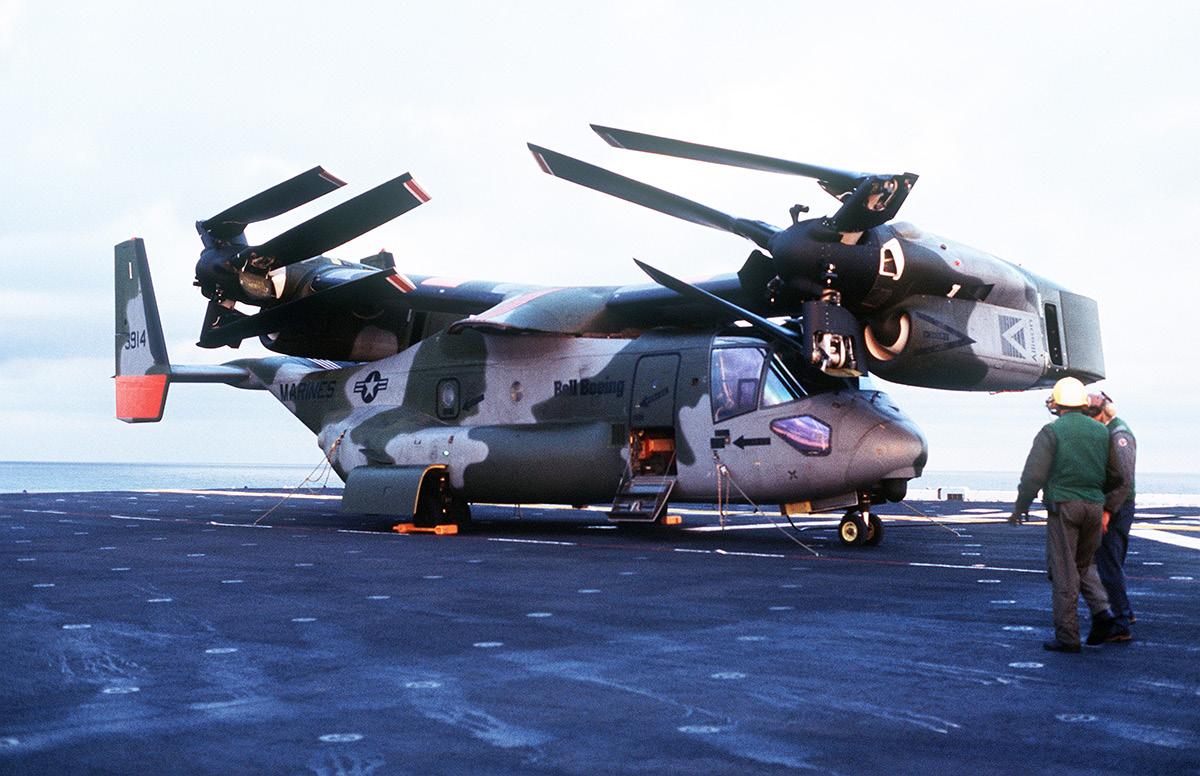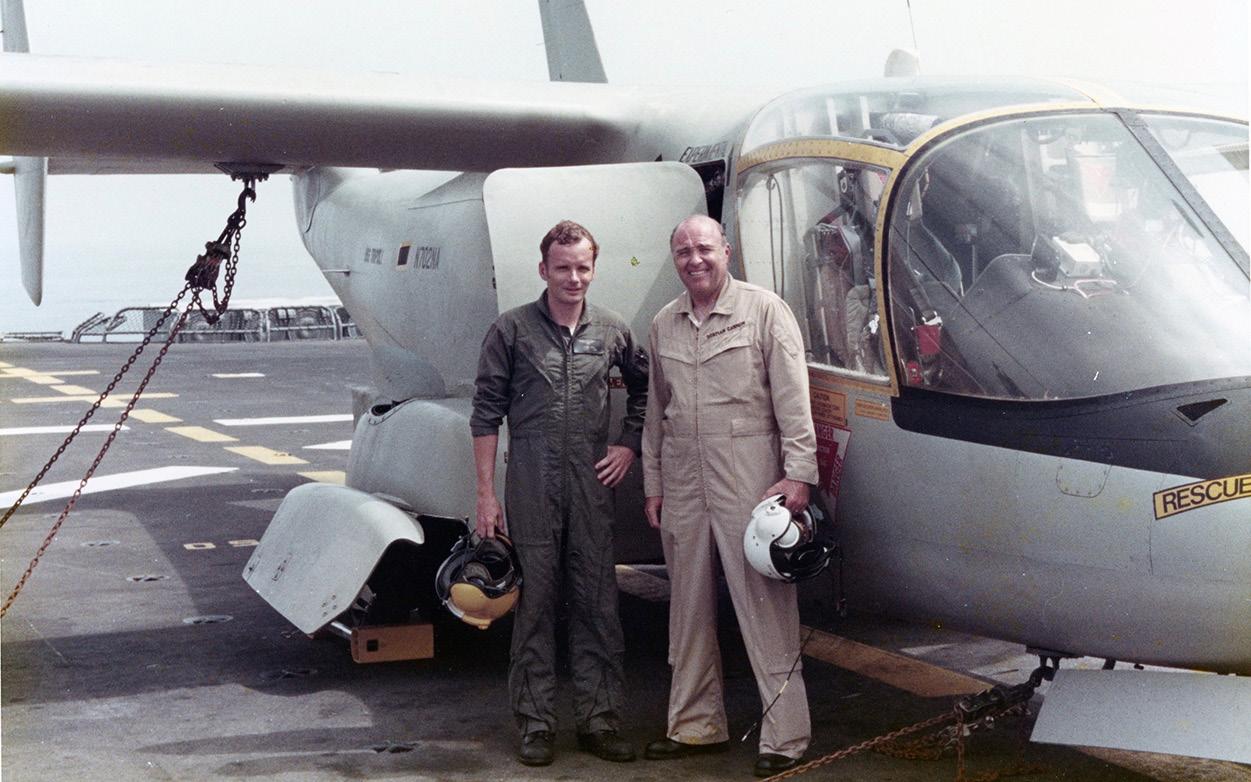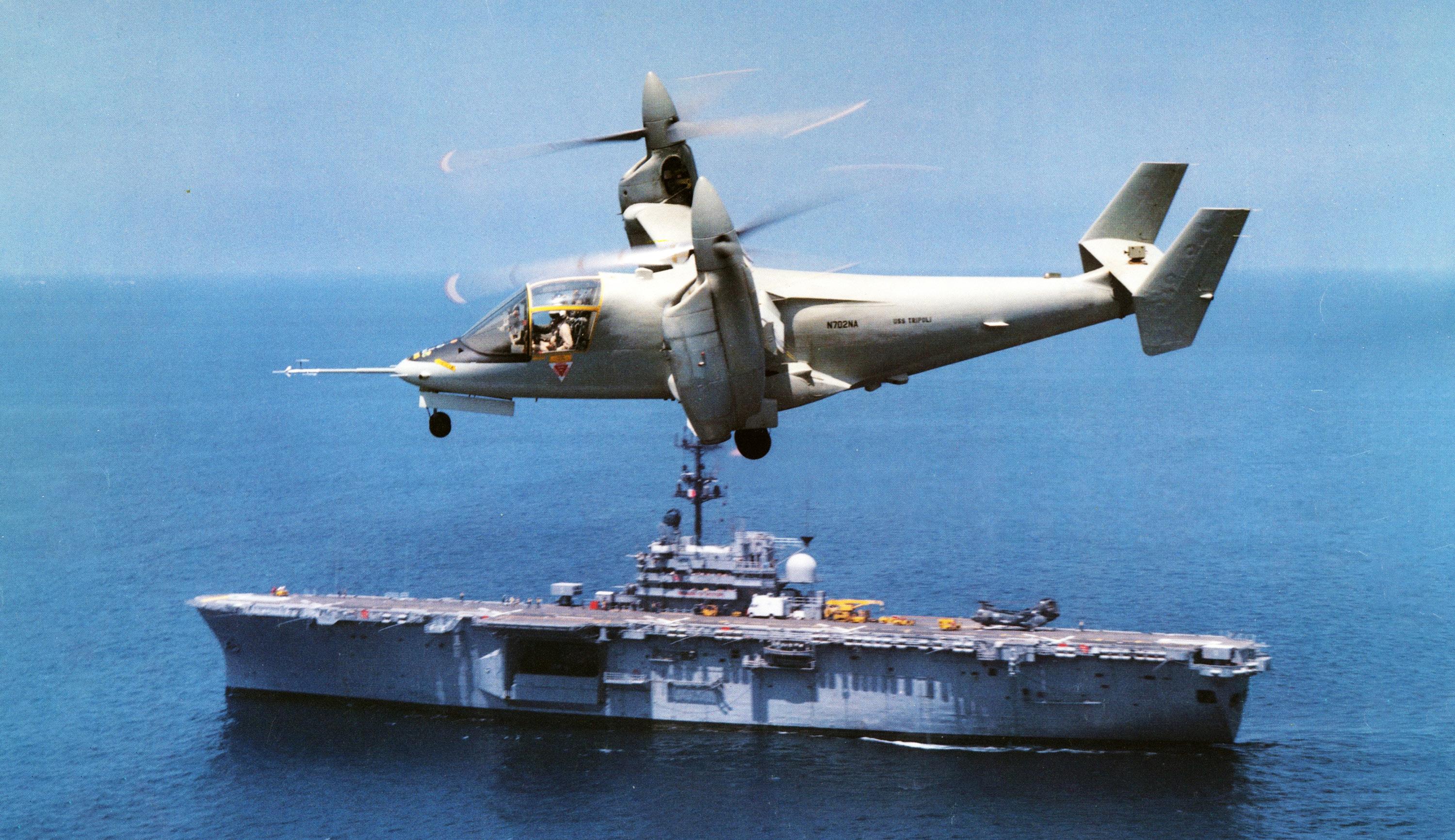
19 minute read
The Origins of the Navy’s New COD Aircraft, the CMV-22B Osprey
The Origins of the Navy’s New COD Aircraft, the CMV-22B Osprey
By CDR John C. Ball, USN (Ret.)
This article focuses on the evolution of the tiltrotor aircraft from an aviation oddity to its proven stature today as a versatile workhorse of the armed forces, including its latest role as the Navy’s new COD aircraft.
The tiltrotor concept is just one of many innovative configurations built since the 1950’s that were envisioned with the ability to fly high and fast yet hover and land virtually anywhere. These have included pure lift jets such as the AV-8 Harrier, tail sitters such as the Ryan XFV-1, ducted fans such as the Bell X-22, and tilt-wings such as the big Tri-Service XC-142. A host of other configurations were designed and flown, yet in the end, the tiltrotor concept has survived as the best compromise for the multi-mission service of transport, shipboard operations, and even external load operations.
Today’s V-22 Osprey is actually the third generation of successful tiltrotors, a configuration type that started flying in the 1950’s. The first tiltrotor to achieve full conversion from helicopter to airplane mode was the Air Force’s XV-3 Convertiplane built by Bell Helicopter. First flown in 1955, it proved the viability of the tiltrotor concept and went on to fly with NASA until 1962. Powered by a reciprocating engine, it was underpowered but did accomplish 110 full conversions from helicopter to airplane mode. Taking advantage of turboshaft engines and lessons learned from the XV-3, the NASA/Army/Navy Bell XV-15 Tilt Rotor Research Aircraft was its successor and had a most successful career from 1977 until its retirement in 2003. This second generation tiltrotor proved the feasibility of the type to fulfill a wide range of missions. Its success helped usher in the development of today’s V-22 Osprey, the third generation tilt rotor.
Flying the XV-15
The V-22 Osprey tiltrotor aircraft has been flying for an incredible 33 years, and I have fond memories of flying a tiltrotor, but not the Osprey. You see, I flew its predecessor, the smaller, experimental Bell XV-15 Tilt Rotor Research Aircraft. As a Navy test pilot in the 1980’s, I had the good fortune of flying the XV-15 in some preliminary military operational tests. The XV-15 - there were two examples - was built by Bell Helicopter under contract to NASA to demonstrate the feasibility of the tiltrotor concept. First flown in 1976, the XV-15 was smaller and much simpler than the V-22, using Army T53 engines and mechanical flight controls. It had a crew of two pilots sitting on ejection seats, with that instrumentation in the small cabin. Flying the XV-15 was straightforward and fun and it became a perfect platform for many guest pilot flights. Although a unique design for its time, its relative simplicity contributed to its legacy as one of the most successful X-planes of all time.
I flew the XV-15 during an exciting assignment at the Naval Air Test Center (NATC). After two tours flying VERTREP in the Navy H-46 Sea Knight (squadrons HC-6 and HC11) and a master’s degree from post-graduate school, I attended Test Pilot School (TPS), a grueling but rewarding year during which I flew 18 different aircraft types. Upon completion of TPS in 1981, I was the lone Navy pilot among five Marines assigned to the Attack/ Assault Branch since I’d flown the H-46. Our branch tested any helicopter types that weren’t anti-submarine warfare (ASW). As the Joint Service Advanced Vertical Lift (JVX) Program developed into an important program, it looked to become the successor to the Navy/Marine H-46 Program. Some visionaries in the Navy recognized the potential of a tiltrotor for naval applications. They wanted to perform some military demonstrations with the experimental XV-15 tiltrotor concept demonstrator, and actually fly the XV-15 on a ship. These demonstrations solidified in 1982 when the Navy allocated $4M for shipboard testing, the Navy earmarked a ship, and NASA made one of the two aircraft available. The ship assigned was USS Tripoli (LPH 10) based in San Diego.

The tests were assigned by NAVAIR to NATC, specifically our branch, and I was fortunate to be assigned as project officer and pilot. As usual, I would team with a Navy civilian flight test engineer to plan and execute the tests. I would fly the XV-15 with Bell’s test pilot, Dorman Cannon, acting as safety pilot. An experienced former Marine, Dorman had flown on the first flight of the Bell XV-15, and later would command the first flight of the Bell-Boeing V-22 in 1989.
As a new test pilot, I learned that there is a lot more to being a Navy test pilot than just flying. I was pleased to team with Mr. Dave DuFresne, an experienced flight test engineer. We began to meticulously plan and orchestrate this “shipboard evaluation” as we called it. We felt the term “sea trials” would be inappropriate since the XV-15 was only an experimental aircraft.
We found that planning this unique flight test with a Navy ship was relatively simple, but making it happen was complex and often frustrating, taking most of our effort. For instance, who would authorize this NASA/Bell aircraft and a civilian pilot to fly off a Navy ship? We had to answer many similar questions and perform a myriad of tasks such as installing tie down rings on the aircraft for shipboard use, training the Navy deck crew to work with this unique aircraft, arranging shipboard fueling, deciding what deck markings to use, coordinating for the NASA telemetry van to be aboard the ship, and planning helo transportation for test observers to and from the ship. To avoid any electromagnetic interference, the ship powered down its radars while the XV-15 was there, and used only a UHF radio. We even mounted a small movie film camera on the tail looking forward - Bell wanted plenty of coverage. At NAVAIR, LCDR Paul Roberts did a superb job of assisting us with cutting through the Navy red tape. And this was in the days before email, the Internet, and even fax machines. Instead we used naval messages, telephone calls, typed letters, carbon paper, and the US Mail.
For my flying role, I prepared by studying Bell’s flight manual and anything else I could find. Our contacts at NAVAIR arranged a familiarization flight for me in NASA’s XV-15 at Ames Research Center on 1 July 1982 where I flew with NASA pilot, Dan Dugan. I clearly recall that when I walked into the pilots’ preflight briefing, I was struck to find a roomful of NASA people there. For a moment, I felt like I was in a briefing for an Apollo moon shot - all for my simple “fam” flight. During our short local flight, Dan showed me the basics of flight in a tiltrotor and the unique accelerations, sensations, and noises especially during transition from helicopter to airplane mode. That’s when the rotor discs rotate 90 degrees, coming down past the canopy. After locking the nacelles in airplane mode, the rotor RPM was lowered from 98% to 86%, with a notable change in noise level. My flight was invaluable, since it highlighted the unique characteristics of the tiltrotor and gave me confidence to jump right into testing.

In mid-July, our small Navy team traveled to San Diego and met the other test personnel. The XV-15 had just flown in from Fort Huachuca where it had flown its first operational tests with the Army, evaluating radar vulnerability and terrain flight. At North Island, we operated from the HS-6 spaces and used the HS-10 flight line. The XV-15 flew in wearing a desert camouflage scheme, done in water-based paint. After a trip to the wash rack, the aircraft returned with its base coat of gray paint, with a small “USS TRIPOLI” and “N702NA” stenciled on each side of the fuselage. It was interesting that as we began flying out of North Island, the base tower operators remarked that we were difficult to see in the typical summer

We spent two weeks on workups ashore, practicing running landings, sideward flight to simulate hovers in a crosswind, landings to a spot, and working with Tripoli’s flight deck crew. To regain ship currency, Dorman and I made landings and takeoffs on Tripoli in an H-46 Sea Knight from North Island based squadron, HC-3.
Finally, on 2 August, Dorman and I started up the X-15, taxied out, and flew seaward, transitioning to airplane mode, always a thrilling acceleration. I was feeling comfortable after my ten flights in the aircraft. We rounded Point Loma at 200 knots and quickly reached the ship offshore. As we approached the ship, we beeped our nacelles aft using the switch on the collective lever, and slowed to 90 knots. We made a slow approach up the stern, stabilized in a hover, and made an easy descent to a touchdown in the center of the deck. It was an uneventful yet historic landing.
There had been concern by Bell management as to which of us would make that first landing, me or Dorman. In the end, he and I decided between ourselves. Dorman, being the true gentleman he was, deferred to me to make that first landing. I thought it interesting that Dorman, except for his few landings the week prior, had made his last ship landing as a Marine pilot in 1966.
It is noteworthy that some Bell photographs of our first landings were flown off the ship that day, developed quickly, and flown to Washington that night, arriving on Capitol Hill the next morning. At this time, the JVX Program was in its infancy and needed support in Congress during debate on the defense budget.
The naysayers questioned what would happen near the deck edge with one rotor over the deck and one rotor over the water. Obviously the XV-15 had a relatively high downwash because of its rotor size, and some people had a genuine concern. However, as an H-46 pilot I had hovered for hours with one rotor on and one rotor off the deck edge over small ships. Nevertheless, to address this concern, we hovered over the catwalk and found no perceptible change in flight characteristics or control positions.
We flew three days of tests on Tripoli, and gradually worked different spots, flew in various wind conditions, used different approach patterns, hovered at various heights, and flew a nifty maneuver we called a rolling takeoff. For this we positioned ourselves just forward of the island, tilted the nacelles slightly forward, pulled collective, released the brakes, and accelerated toward the bow, lifting off in less than 100 feet. This takeoff used much less than hover power and was an obvious takeoff method for heavy weights, like a Harrier. One day, to our surprise, Dorman and I were told by the Air Boss that we had just made the 60,000th landing on Tripoli, which was celebrated with a traditional Navy sheet cake on the flight deck during a refueling break.
In all, we spent three days at the ship, flying out each morning from North Island. We performed 54 takeoffs and landings with no issues and completed all test objectives, including plenty of photographs and videos.
So after the excitement of the tests, Dave DuFresne and I hunkered down to begin writing the formal technical report, a document more boring than NATOPS. We gathered and crunched the data, generated charts, and made recommendations. One was to include a chin bubble window in future tiltrotors, to aid in precise landings. Common in helicopters, the XV-15 did not have one, and its absence quickly became apparent to me at the ship. Early concept drawings for the V-22 did not include a chin bubble. When the V-22 was built, it did have one, and I like to think that our report made the difference.

After our shipboard evaluation, our Pentagon sponsor arranged for us to brief OP-05, VADM Schoultz, and a host of others in the Pentagon. I focused for days by preparing my briefing, a state-of-the-art multi-media presentation consisting of colorful technical VU-graphs and 16 mm videoclips. I spent long days perfecting it at the photo lab, where we spliced film clips and tweaked my slides. This was my first and only trip to the Pentagon, where we were hosted by our sponsor, CAPT Jim Magee, a former squadron CO of mine. It was pretty heady stuff for this O-4 from Pax River to brief a group of very senior officers. I thought my briefing was going well until I noticed an admiral clearly dozing off in the front row of the darkened room. Well, it was after lunch, but it sure didn’t do anything for my ego. Nevertheless, the audience did impress upon me the weight the Navy placed on the opinions of its test pilots.

Following the success of this project, the Navy arranged follow-on testing to investigate the potential of a tiltrotor for external loads and personnel rescue. So the following year, I was reunited with Dorman Cannon and the same XV-15 at Bell’s experimental facility at Arlington Airport, Texas, the home of Bell’s XV-15. This time the XV-15 sported some bright orange panels over that gray paint, a sensible way to make the aircraft more visible around the airport. In May 1983, I flew a short program of three test flights. Two flights consisted of overwater hovers, a practical evaluation of the downwash while hovering at Mountain Creek Lake adjacent to NAS Dallas, only a few miles from Bell’s facility. Like most lakes in Texas, it was actually a reservoir of fresh water, which eliminated any concern of salt water ingestion by the aircraft. Except for one high hover at sea during the Tripoli flights, the XV-15 had not hovered overwater, so these tests were essential to see the effects of a tiltrotor’s unique downwash pattern on spray ingestion, the effects of ambient winds on the downwash, and the ability to rescue a person from the water. No attempt was made to actually hoist a person, since the XV-15 was certainly not suitable for that. We did employ two Navy rescue swimmers who were deployed by boat into the lake and acted as “survivors” and rescue swimmers. They concluded that a tilt rotor could be used for these missions and its downwash effects were comparable to those of Fleet helicopters.
More Tiltrotor Navy Testing
Next was a single flight at Bell’s facility, this time with personnel under the aircraft, as if hooking up an external load. Again, this was another first, and showed that personnel could work underneath a hovering tilt rotor. As expected, the downwash characteristics were different from a helicopter, with the strongest downwash being low to the ground, making walking challenging. Nevertheless, we concluded that a tilt rotor could be used for external loads.
The tests with the XV-15 tiltrotor were representative of a smaller aircraft than the V-22, which would be roughly twice the size and three times the weight of the XV-15. The effects of this scale-up would be evaluated years later, during the V-22’s engineering and operational testing.
Beginnings of the V-22 Program
In 1982 the Army, Air Force, and Marines conducted a study to identify a vehicle best suited for their future missions. The study concluded that a tiltrotor best met those requirements. Thus began the JVX Program that resulted in development of today’s V-22. In 1985, the V-22 was officially named the Osprey. In 1986, Full Scale Development was authorized, and the team of Bell-Boeing set to work building six prototypes. The Army decided to leave the program in 1988, leaving the Marine Corps with its MV-22 model, and the Air Force with its Special Operations CV-22. The first flight of a V-22 took place on March 19, 1989 followed by an aggressive test program, primarily at Naval Air Test Center, NAS Patuxent River where an Integrated Test Team was based, with both contractor and military pilots. An early milestone was recorded on 4 December 1990, when V-22 prototype number four landed aboard USS Wasp (LHD 1) for the first V-22 ship landing.
Retirement of the XV-15
As the V-22 began flying, it overshadowed the XV-15, which transitioned from being a cutting-edge aeronautical achievement to a proven aircraft that could demonstrate what a future tiltrotor could do. NASA operating funds dwindled and the two experimental XV-15s were no longer cutting-edge aviation. The two aircraft were bailed to Bell and they served useful roles as testbeds, demonstrators, and promotional vehicles for a civil tiltrotor. In fact, for its appearance in the 1995 Paris Air Show, the XV-15 was painted in a snappy executive livery, complete with painted faux cabin windows that belied its origins as an experimental concept demonstrator

One of its most effective roles was for guest pilot flights. These provided a priceless experience to notable and influential people such as Senator Barry Goldwater, Secretary of the Navy John Lehman, and numerous flag officers. From 1981 to 2003, a total of 419 guest pilots flew in one of the two XV15s, a record for an X-plane.
After my retirement from the Navy, I began an exciting nine years as an experimental test pilot at Bell Helicopter in Texas, flying nearly every Bell aircraft of the day, including the XV15 again. Thus, I was able to fly both examples of the XV15, N702NA on active duty, and later N703NA when it was bailed to Bell, including thrilling daily demonstrations with a V-22 in the 1995 Paris Air Show. I consider my 156 hours in the XV-15 to be a highlight of my 30-year flying career.
After 26 years of flight operations, the last XV-15 was finally retired. In September 2003, N703NA was flown to the National Air & Space Museum Udvar-Hazy Center at Dulles Airport in Virginia, where today it sits on display near the nose of the supersonic Concorde.
The Osprey Matures
After its initial successes, the V-22 Program experienced over a decade of controversy, fueled by its rising costs and fatal accidents. Between 1991 and 2000, four major accidents occurred and there were two extended groundings. The program was even formally canceled by the Pentagon, yet the Marine Corps continued its support, and the Congress funded the program until it was included again in the President’s Budget. The scrutiny led to important redesigns, resulting in today’s improved V-22B model.
After the second grounding was lifted in 2002, the new V-22Bs began technical and operational testing anew. The Air Force received its first CV-22s at Edwards AFB in 2003. Extensive shipboard trials were flown in 2004 and 2005. The MV-22 Initial Operational Capability (IOC) was achieved in 2007 and Marine Corps deployments began that year. Since then, Ospreys have been deployed by the Air Force and Marine Corps throughout the world. Today, over 400 examples have been delivered to the Marines, Air Force, Navy, and recently to Japan’s Ground Self-Defense Force, its first foreign customer.
For years the Navy knew it needed a replacement for the C-2 Greyhound in its COD mission that it has been performing since 1966. Despite upgrades over the years, an aircraft was needed that could transport the huge F-35C power module, something the C-2 could not do. In 2015, the proven success of the V-22 led to its selection as the COD replacement for the C-2 Greyhound.
To support its new aircraft, the Navy established the Fleet Logistics Multi-Mission (VRM) Wing at NAS North Island to provide VRM squadrons. The Navy’s first Osprey squadron, VRM-50, was established at NAS North Island in October 2020 as the Fleet Replacement unit. Two months later, the first operational squadron, VRM-30, was established at NAS North Island. It provided the aircraft and crews for the first deployment aboard USS Carl Vinson (CVN 70).
The CMV-22B is designed to carry up to 6,000 pounds of cargo and/or personnel and operate up to a range of 1,150 nautical miles. A few changes were made to the Marines’ MV22B to equip it for the Navy mission. The Navy variant has extended range tanks in each sponson and wing, a beyond line-of-sight HF radio, improved fuel dump capability, a public address system for passengers, and an improved lighting system for cargo loading.
The first flight of a CMV-22B was made on 21 January 2020 at Bell’s production facility in Amarillo, Texas. That October, the first ship landings and takeoffs were made by a CMV-22B aboard the amphibious transport dock, USS New York (LPD 21). A month later, its first operations from an aircraft carrier took place aboard USS Carl Vinson (CVN 70).
Following the return of CVW-2’s deployment, the Navy’s Air Boss, VADM Whitesell, summed up the CMV-22B’s role, saying, “With distributed maritime ops, longer ranges, distances between multi-carrier operations, distances from land-based areas, and the ability for the CMV-22B to plop down on unimproved surfaces, it proved to be a game-changer for us on deployment."
Adapted from the author’s article that first appeared in the Tailhook Association’s The Hook magazine, Fall 2022 issue.












